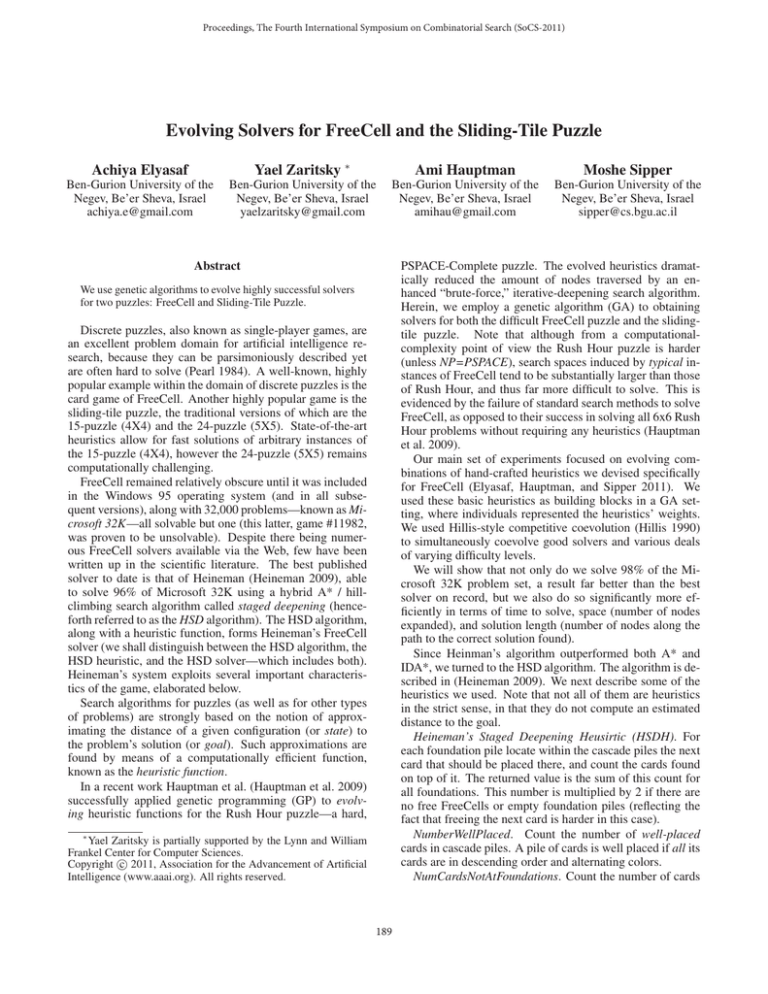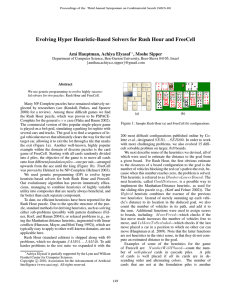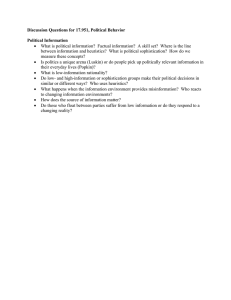
Proceedings, The Fourth International Symposium on Combinatorial Search (SoCS-2011)
Evolving Solvers for FreeCell and the Sliding-Tile Puzzle
Achiya Elyasaf
Yael Zaritsky ∗
Ami Hauptman
Moshe Sipper
Ben-Gurion University of the
Negev, Be’er Sheva, Israel
achiya.e@gmail.com
Ben-Gurion University of the
Negev, Be’er Sheva, Israel
yaelzaritsky@gmail.com
Ben-Gurion University of the
Negev, Be’er Sheva, Israel
amihau@gmail.com
Ben-Gurion University of the
Negev, Be’er Sheva, Israel
sipper@cs.bgu.ac.il
PSPACE-Complete puzzle. The evolved heuristics dramatically reduced the amount of nodes traversed by an enhanced “brute-force,” iterative-deepening search algorithm.
Herein, we employ a genetic algorithm (GA) to obtaining
solvers for both the difficult FreeCell puzzle and the slidingtile puzzle. Note that although from a computationalcomplexity point of view the Rush Hour puzzle is harder
(unless NP=PSPACE), search spaces induced by typical instances of FreeCell tend to be substantially larger than those
of Rush Hour, and thus far more difficult to solve. This is
evidenced by the failure of standard search methods to solve
FreeCell, as opposed to their success in solving all 6x6 Rush
Hour problems without requiring any heuristics (Hauptman
et al. 2009).
Our main set of experiments focused on evolving combinations of hand-crafted heuristics we devised specifically
for FreeCell (Elyasaf, Hauptman, and Sipper 2011). We
used these basic heuristics as building blocks in a GA setting, where individuals represented the heuristics’ weights.
We used Hillis-style competitive coevolution (Hillis 1990)
to simultaneously coevolve good solvers and various deals
of varying difficulty levels.
We will show that not only do we solve 98% of the Microsoft 32K problem set, a result far better than the best
solver on record, but we also do so significantly more efficiently in terms of time to solve, space (number of nodes
expanded), and solution length (number of nodes along the
path to the correct solution found).
Since Heinman’s algorithm outperformed both A* and
IDA*, we turned to the HSD algorithm. The algorithm is described in (Heineman 2009). We next describe some of the
heuristics we used. Note that not all of them are heuristics
in the strict sense, in that they do not compute an estimated
distance to the goal.
Heineman’s Staged Deepening Heusirtic (HSDH). For
each foundation pile locate within the cascade piles the next
card that should be placed there, and count the cards found
on top of it. The returned value is the sum of this count for
all foundations. This number is multiplied by 2 if there are
no free FreeCells or empty foundation piles (reflecting the
fact that freeing the next card is harder in this case).
NumberWellPlaced. Count the number of well-placed
cards in cascade piles. A pile of cards is well placed if all its
cards are in descending order and alternating colors.
NumCardsNotAtFoundations. Count the number of cards
Abstract
We use genetic algorithms to evolve highly successful solvers
for two puzzles: FreeCell and Sliding-Tile Puzzle.
Discrete puzzles, also known as single-player games, are
an excellent problem domain for artificial intelligence research, because they can be parsimoniously described yet
are often hard to solve (Pearl 1984). A well-known, highly
popular example within the domain of discrete puzzles is the
card game of FreeCell. Another highly popular game is the
sliding-tile puzzle, the traditional versions of which are the
15-puzzle (4X4) and the 24-puzzle (5X5). State-of-the-art
heuristics allow for fast solutions of arbitrary instances of
the 15-puzzle (4X4), however the 24-puzzle (5X5) remains
computationally challenging.
FreeCell remained relatively obscure until it was included
in the Windows 95 operating system (and in all subsequent versions), along with 32,000 problems—known as Microsoft 32K—all solvable but one (this latter, game #11982,
was proven to be unsolvable). Despite there being numerous FreeCell solvers available via the Web, few have been
written up in the scientific literature. The best published
solver to date is that of Heineman (Heineman 2009), able
to solve 96% of Microsoft 32K using a hybrid A* / hillclimbing search algorithm called staged deepening (henceforth referred to as the HSD algorithm). The HSD algorithm,
along with a heuristic function, forms Heineman’s FreeCell
solver (we shall distinguish between the HSD algorithm, the
HSD heuristic, and the HSD solver—which includes both).
Heineman’s system exploits several important characteristics of the game, elaborated below.
Search algorithms for puzzles (as well as for other types
of problems) are strongly based on the notion of approximating the distance of a given configuration (or state) to
the problem’s solution (or goal). Such approximations are
found by means of a computationally efficient function,
known as the heuristic function.
In a recent work Hauptman et al. (Hauptman et al. 2009)
successfully applied genetic programming (GP) to evolving heuristic functions for the Rush Hour puzzle—a hard,
∗
Yael Zaritsky is partially supported by the Lynn and William
Frankel Center for Computer Sciences.
c 2011, Association for the Advancement of Artificial
Copyright Intelligence (www.aaai.org). All rights reserved.
189
that are not at the foundation piles.
Examples of some of the heuristics for the sliding-tile
puzzle are:
ManhattanDistance. For each tile count how many moves
it will take to get to its goal position, assuming it is the only
tile on the board.
GeometricMean. The geometric mean of the Manhattan
distances of all tiles.
LinearConflict. Two tiles tj and tk are in a linear conflict
if tj and tk are situated along the same horizontal line, the
goal positions of tj and tk are both along that line, tj is to
the right of tk , and the goal position of tj is to the left of
the goal position of tk . Every linear conflict increments the
heuristic value by one.
PDB. All of the 4-tile combinations of PDBs for the 15puzzle were taken as different heuristics.
Experiments with each of these heuristics demonstrated
that most of them were not good enough to guide search for
these difficult domains. Thus we turned to evolution.
Combining several heuristics to get a more accurate one is
considered one of the most difficult problems in contemporary heuristics research (Burke et al. 2010; Samadi, Felner,
and Schaeffer 2008). Herein we tackle a sub-problem, that
of combining heuristics by arithmetic means, e.g., by summing their values or taking the maximal value.
Each individual comprises n real values in the range
[0, 1), representing a linear combination of all n heuristics.
Specifically, the heuristic value, H, designated by an evolvn
ing individual is defined as H = i=1 wi hi , where wi is the
ith weight specified by the genome, and hi is the ith heuristic. To obtain a more uniform calculation we normalized all
heuristic values to within the range [0, 1] by maintaining a
maximal possible value for each heuristic, and dividing by
it.
We used standard fitness-proportionate selection and
single-point crossover. Mutation was performed in a manner
analogous to bitwise mutation by replacing with independent probability 0.1 a (real-valued) weight by a new random
value in the range [0, 1).
A FreeCell individual’s fitness score was obtained by performing full HSD search on deals taken from the training
set, with the individual used as the heuristic function. Fitness equaled the average search-node reduction ratio. This
ratio was obtained by comparing the reduction in number of
search nodes—averaged over solved deals—with the average number of nodes when searching with the original HSD
heuristic (HSDH).
We used Hillis-style of coevolution wherein a population of solutions coevolves alongside a population of problems (Hillis 1990). The basic idea is that neither population should stagnate: As solvers become more adept at
solving certain problems these latter do not remain in the
problem set but are rather removed from the population of
problems—which itself evolves. In this form of competitive
coevolution the fitness of one population is inversely related
to the fitness of the other population.
In our coevolutionary scenario the first population comprises the solvers, as described above. In the second population an individual represents a set of 6 FreeCell deals se-
lected from Microsoft 32K. The genome and genetic operators of the both populations were identical to those defined
above.
Our top evolved individual, dubbed GA-FreeCell, solved
98% of Microsoft 32K, thus outperforming HSDH, the
(now) previously top solver, which solved only 96% of Microsoft 32K. The average number of nodes, solution time
and solution length were 230K, 2.9 and 151, respectively.
Thus reducing the amount of search, solution time and solution length by 87%, 93% and 41%, respectively, compared
to HSDH. Note that although GA-FreeCell solves “only” 2%
more instances, these 2% are far harder to solve due to the
long tail of the learning curve.
We are currently performing experiments on the slidingtile puzzle, with promising initial results: Our best evolved
solver outperforms all the solvers but one presented in (Arfaee, Zilles, and Holte 2010), in terms of nodes and time.
Our solver solved 1000 test instances with an average number of nodes of 4,991 and average solution time of 0.03.
However, the solution lengths are longer, and we assume this
is a consequence of using weighted A* with large weights.
Our current experiments, which we hope to report upon in
the near future, use a variety of weights.
References
Arfaee, S. J.; Zilles, S.; and Holte, R. C. 2010. Bootstrap learning of heuristic functions. In In Proceedings of
the 3rd International Symposium on Combinatorial Search
(SoCS2010), 52–59.
Burke, E. K.; Hyde, M.; Kendall, G.; Ochoa, G.; Ozcan,
E.; and Woodward, J. R. 2010. A classification of hyperheuristic approaches. In Gendreau, M., and Potvin, J., eds.,
Handbook of Meta-Heuristics 2nd Edition. Springer. 449–
468.
Elyasaf, A.; Hauptman, A.; and Sipper, M. 2011. GAFreeCell: Evolving solvers for the game of FreeCell. In
Proceedings of the Genetic and Evolutionary Computation
Conference (GECCO 2011). ACM. (to appear).
Hauptman, A.; Elyasaf, A.; Sipper, M.; and Karmon, A.
2009. GP-Rush: using genetic programming to evolve
solvers for the Rush Hour puzzle. In GECCO’09: Proceedings of 11th Annual Conference on Genetic and Evolutionary Computation Conference, 955–962. New York, NY,
USA: ACM.
Heineman, G. T. 2009. Algorithm to solve FreeCell solitaire games. http://broadcast.oreilly.com/2009/01/januarycolumn-graph-algorithm.html. Blog column associated with
the book “Algorithms in a Nutshell book,” by G. T. Heineman, G. Pollice, and S. Selkow, O’Reilly Media, 2008.
Hillis, D. W. 1990. Co-evolving parasites improve simulated
evolution in an optimization procedure. Physica D 42:228–
234.
Pearl, J. 1984. Heuristics. Reading, Massachusetts:
Addison–Wesley.
Samadi, M.; Felner, A.; and Schaeffer, J. 2008. Learning
from multiple heuristics. In Fox, D., and Gomes, C. P., eds.,
Proceedings of the Twenty-Third AAAI Conference on Artificial Intelligence (AAAI 2008), 357–362. AAAI Press.
190









